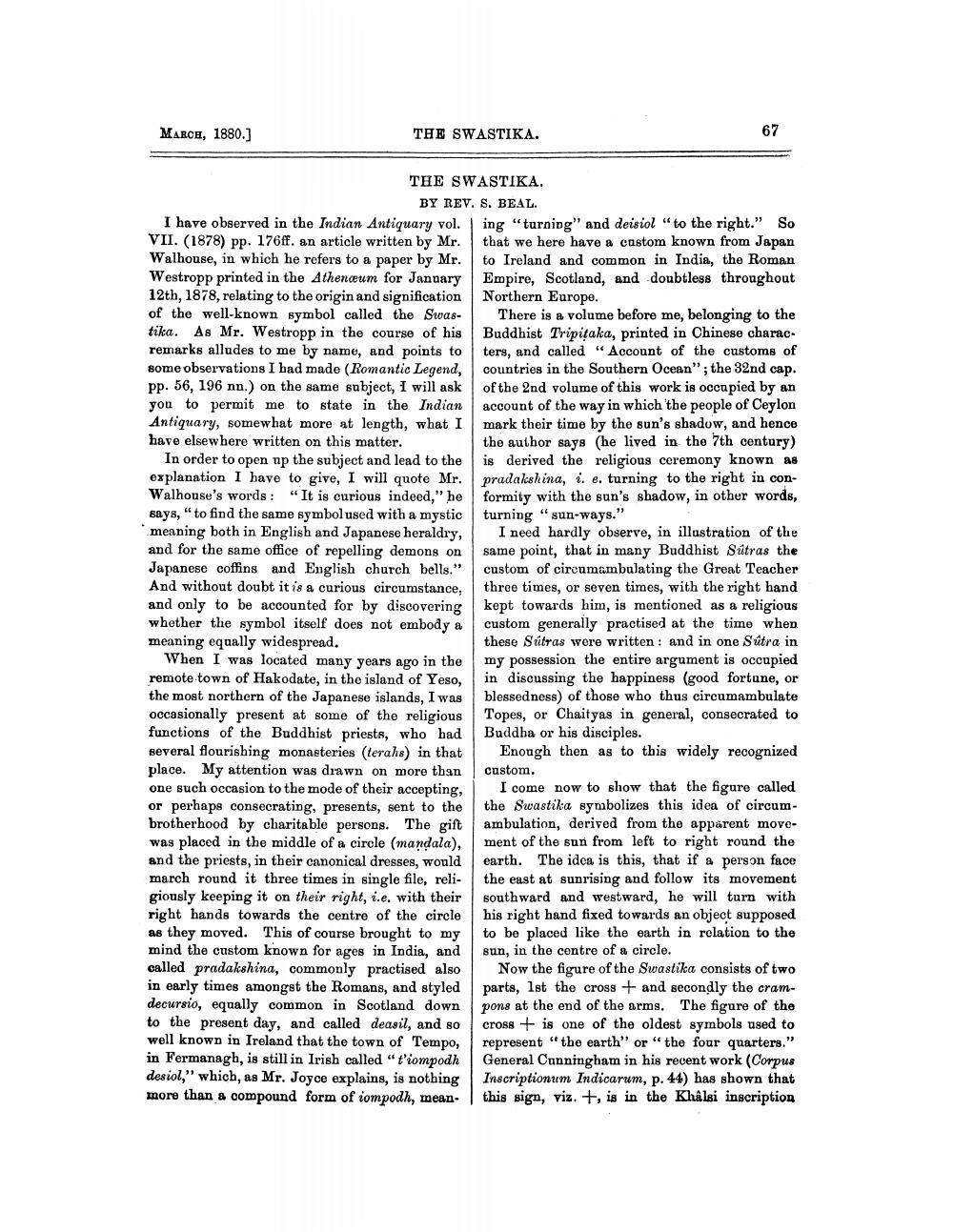________________
MARCH, 1880.]
THE SWASTIKA.
THE SWASTIKA.
BY REV. S. BEAL. I have observed in the Indian Antiquary vol. ing "turning and deisiol "to the right." So VII. (1878) pp. 176ff. an article written by Mr. that we here have a castom known from Japan Walhouse, in which he refers to a paper by Mr. to Ireland and common in India, the Roman Westropp printed in the Atheneum for January Empire, Scotland, and doubtless throughout 12th, 1878, relating to the origin and signification Northern Europe. of the well-known symbol called the Swas- There is a volume before me, belonging to the tika. As Mr. Westropp in the course of his Buddhist Tripitaka, printed in Chinese characremarks alludes to me by name, and points to ters, and called "Account of the customs of some observations I had made (Romantic Legend, countries in the Southern Ocean"; the 32nd cap. pp. 56, 196 nn.) on the same subject, I will ask of the 2nd volume of this work is occupied by an you to permit me to state in the Indian account of the way in which the people of Ceylon Antiquary, somewhat more at length, what I mark their time by the sun's shadow, and hence have elsewhere written on this matter.
the author says he lived in the 7th century) In order to open up the subject and lead to the is derived the religious ceremony known as explanation I have to give, I will quote Mr. pradakshina, i.e. turning to the right in conWalhouse's words: “It is curious indeed," he formity with the sun's shadow, in other words, says, " to find the same symbol used with a mystic turning "sun-ways." meaning both in English and Japanese heraldry, I need hardly observe, in illustration of the and for the same office of repelling demons on same point, that in many Buddhist Sútras the Japanese coffins and English church bells." custom of circumambalating the Great Teacher And without doubt it is a curious circumstance, three times, or seven times, with the right hand and only to be accounted for by discovering kept towards him, is mentioned as a religious whether the symbol itself does not embody a custom generally practised at the time when meaning equally widespread.
these Sútras were written: and in one Sútra in When I was located many years ago in the my possession the entire argument is occupied remote town of Hakodate, in the island of Yeso, in discussing the happiness (good fortune, or the most northern of the Japanese islands, I was blessedness) of those who thus circumambulate occasionally present at some of the religious Topes, or Chaityas in general, consecrated to functions of the Buddhist priests, who had Buddha or his disciples. several flourishing monasteries (terahs) in that Enough then as to this widely recognized place. My attention was drawn on more than custom. one such occasion to the mode of their accepting, I come now to show that the figure called or perhaps consecrating, presents, sent to the the Swastika symbolizes this idea of circumbrotherhood by charitable persons. The gift ambulation, derived from the apparent movewas placed in the middle of a circle (mandala), ment of the sun from left to right round the and the priests, in their canonical dresses, would earth. The idea is this, that if a person face march round it three times in single file, reli- the east at sunrising and follow its movement giously keeping it on their right, i.e. with their southward and westward, he will turn with right hands towards the centre of the circle his right hand fixed towards an object supposed as they moved. This of course brought to my to be placed like the earth in relation to the mind the custom known for ages in India, and sun, in the centre of a circle. called pradakshina, commonly practised also Now the figure of the Swastika consists of two in early times amongst the Romans, and styled parts, lst the cross + and secondly the cramdecursio, equally common in Scotland down pons at the end of the arms. The figure of the to the present day, and called deasil, and so cross + is one of the oldest symbols used to well known in Ireland that the town of Tempo, represent "the earth" or "the four quarters." in Fermanagh, is still in Irish called " t'iompodh General Cunningham in his recent work (Corpus desiol," which, as Mr. Joyce explains, is nothing Inscriptionum Indicarum, p. 44) has shown that more than a compound form of compodh, mean. this sign, viz. +, is in the Khálsi inscription




